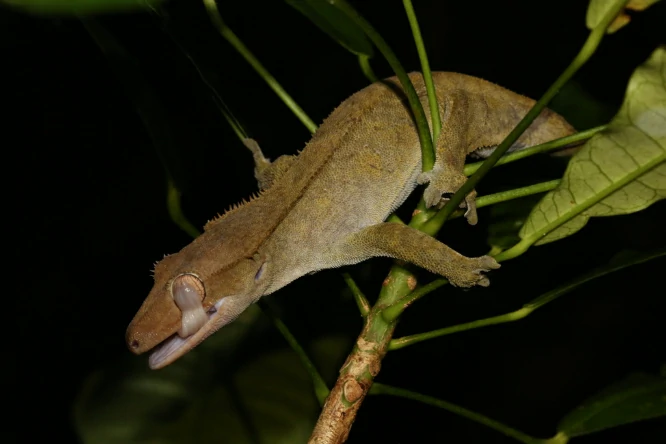You’re watching your gecko explore its little terrarium. Its tiny feet stick to the glass as it moves, pausing to flick its tongue out. You blink and lean in closer.
You’ve seen it do this before, but this time you wonder, what is that tongue really for? Do geckos actually use their tongues for anything important, or is it just a weird little quirk?
Yes, geckos use their tongues all the time, and for several important purposes. Their tongues aren’t just for tasting. They help clean the eyes, capture food, sense the environment, and even keep the skin in good condition. That little flicking motion is a multitool in action.
Geckos Use Their Tongues for Taste and Smell
A tongue might seem like it’s just for tasting, but geckos use theirs in a more complex way. Inside the roof of their mouth is the Jacobson’s organ, also called the vomeronasal organ.

When a gecko flicks its tongue, it picks up tiny particles from the air or surfaces and presses them against this organ to “smell” the environment.
If a gecko flicks at the corner of its terrarium, it could be sensing insects nearby or detecting the scent of another gecko. In the wild, this helps them find prey, avoid predators, and even locate potential mates.
That rapid tongue flick is like a tiny, scaly detective gathering clues about the world.
Geckos Use Their Tongues for Eating
Geckos also use their tongues to eat, but not in the way you might think. In some species, like Tokay geckos, the tongue helps guide prey into the mouth. Smaller geckos, such as leopard or crested geckos, rely on the tongue to adjust food after biting.
When a gecko catches a cricket, the tongue moves the prey into the right position for swallowing.
Because geckos don’t chew, the tongue acts like tiny hands inside the mouth, constantly adjusting and guiding food so it can be safely swallowed.
Geckos Use Their Tongues to Clean Their Eyes
Many geckos don’t have eyelids. Instead, they have a transparent scale called a spectacle over each eye. To keep it clean, they use their tongue.
You might see a gecko raise its head and lick its eye. The tongue wipes away dust, debris, or leftover shed skin. This keeps the eyes healthy and functional.

Without this behavior, a gecko might struggle to see predators or prey. It’s a clever adaptation. Sticky tongues weren’t just for eating. They help maintain vision too.
Geckos Use Their Tongues for Shedding and Skin Care
Geckos shed their skin regularly, and the tongue helps here as well. After shedding, a gecko may lick off remaining bits of skin, especially around the eyes or toes.
Removing leftover shed isn’t just cosmetic. It prevents bacteria or fungi from growing and causing infections.
When a gecko flicks its tongue across its body, it’s practicing self-care. That motion you see is a hygienic habit.
Geckos Use Their Tongues for Communication
Some researchers believe geckos use their tongues to communicate, especially species that are territorial. By flicking their tongue and touching surfaces, geckos can leave chemical cues.

Other geckos can detect these with their own tongues, learning who has been in the area, whether it’s a mate or a rival.
It’s like leaving a little post-it note for the next gecko. This behavior may be subtle, but it’s important in the wild for survival and reproduction.
The Tongue as a Multi-Purpose Tool
When you step back, the gecko’s tongue is incredibly versatile. It:
-
Samples the environment for food, predators, or mates
-
Guides and manipulates food in the mouth
-
Cleans the eyes to maintain vision
-
Removes leftover shed skin for hygiene
-
Deposits chemical cues for communication
That’s a lot of jobs for something so small. The flicking motion is quick and precise, a testament to how well geckos are adapted to their world.
A Closer Look at the Tongue Structure
A gecko’s tongue looks simple, but it’s muscular, flexible, and covered in tiny taste buds and sensory cells.
Some species have slightly sticky tongues to manipulate prey. The tongue is fast and precise. When a gecko flicks it, the motion is almost instantaneous.
This speed can make the difference between catching a meal or going hungry. The tongue is an extension of the gecko’s senses, giving them information that sight or touch alone can’t provide.
How Pet Geckos Use Their Tongues
If you keep geckos as pets, it helps to understand their tongue behavior. Licking eyes or surroundings is normal. Frequent flicking is usually natural, not a sign of stress.
Exceptions exist. Constant licking or scraping could indicate mites, stuck shed, or eye irritation. Observing context is important. Providing clean water, safe surfaces, and proper humidity supports healthy tongue use without stress.
Conclusion
Do geckos use their tongues? Absolutely. That little pink or orange flick is doing much more than tasting food. Geckos use their tongues to sense their environment, manipulate prey, clean their eyes, remove shed skin, and even communicate chemically.
Next time you watch your gecko flick its tongue, remember it’s a tiny, versatile tool, carefully honed by evolution to keep the gecko alive, healthy, and thriving.
It’s biology in action, showing that even the smallest creatures have clever ways to navigate the world.
Hi, my name is Ezra Mushala, i have been interested animals all my life. I am the main author and editor here at snakeinformer.com.

